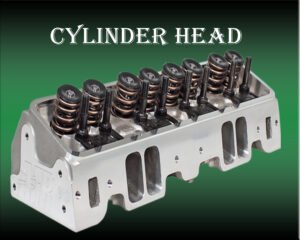
The cylinder head forms the upper part of the engine, the lower part being usually called the engine block. It is an essential part that closes the combustion chamber and helps control the flow of air in and out of the cylinders, as well as the deployment of fuel.
It is also an extremely robust part, as it must withstand enormous pressures and very high temperatures, while maintaining its shape to seal the cylinder block via the head gasket. Its structure is complex and for this reason it is one of the most expensive auto parts.
It is made of aluminum alloy, a very strong metal that withstands high temperatures, a necessity given the exposure of the cylinder head to very high temperatures during combustion.
It can come in many different forms, depending in particular on the type of engine and fuel used.
Intake and exhaust pipes and valves. The former allow the air-fuel mixture to enter, while the latter allow the gases generated by combustion to be evacuated.
Cooling devices.
These are water chambers for liquid-cooled engines or large fins for air-cooled engines.
Camshafts.
They regulate the opening and closing of the valves. They are driven by a crankshaft, itself driven by the timing belt.
The injection system
. The various injectors make it possible to precisely supply the dose of fuel necessary for the correct operation of the engine.
The ignition system.
It allows combustion of the air/fuel mixture in the chamber, using spark plugs on petrol engines and glow plugs on diesel engines.
Oil intake ducts.
This allows oil to be routed to the camshaft and valves to lubricate them.
The fixing device between the cylinder head and the engine block. A set of screws and studs is used to fix the cylinder head gasket and guarantee the tightness of the system.
How do you know that the cylinder head is damaged?
Unless you carry out a thorough inspection in a garage, it is difficult to see certain damage such as cracks on a cylinder head.
An oil leak. Oil in the cylinder head may start to leak if the cylinder head is cracked or if there are problems with the gasket. You can expect the oil light to come on on the dashboard if this is the case. Open the hood and check for oil near the cylinder head.
How to know that the cylinder head is damaged
A coolant leak. This can happen when the cylinder head is badly cracked. The engine may then overheat, which will be indicated by the warning light on the dashboard. It is therefore recommended to regularly check the amount of coolant.
Engine weakness. This is one of the first symptoms that the cylinder head may be damaged. If it is cracked and compressed air is coming out of the combustion chamber, then the engine is likely to run much slower.
Smoke billowing. This is still rare, but large cracks in the cylinder head can allow exhaust gases to escape. The result: smoke billowing from the engine. This is clearly a sign that you need to get a new cylinder head immediately.
Engine ignition difficulties. This is again a concern related to cracks in the cylinder head. The mixture in the combustion chamber is no longer sufficient to start the engine, or it starts to die out repeatedly while you are driving and you will have to restart it constantly.
Cylinder head faults
We have seen that the structure of the cylinder head is complex, which explains the variety of failures that can be encountered.
First of all, it can end up cracking in several places, due to the high temperatures and vibrations caused by the operation of the engine. However, head gasket leakage, linked to a build-up of friction, remains the most common and dreaded failure.
This component, located between the engine block and the cylinder head, has a simple but very important function: it is used to seal and compress the cylinder in order to prevent any leakage of liquid into the engine.
It is a component that should be replaced every 300,000 km in theory, but the condition of which should be checked, because if damaged, it could cause serious damage to the cylinder and the functionality of the engine. general.
The injectors can also cause a problem by getting stuck in the cylinder head when they are a little seized up due to carbon build-up. It is possible to loosen them with penetrating oil after having cleaned them and removed the scale (using a high-pressure jet for example).

